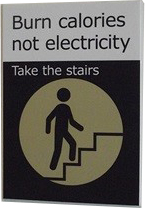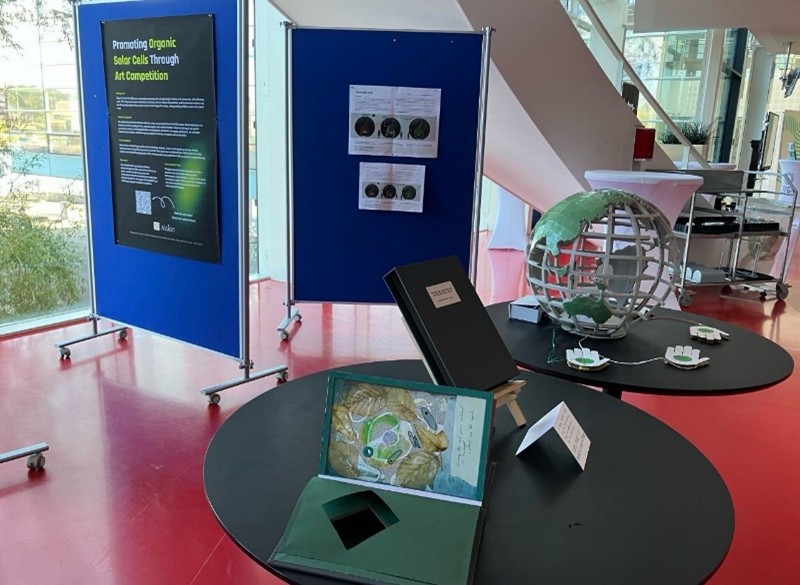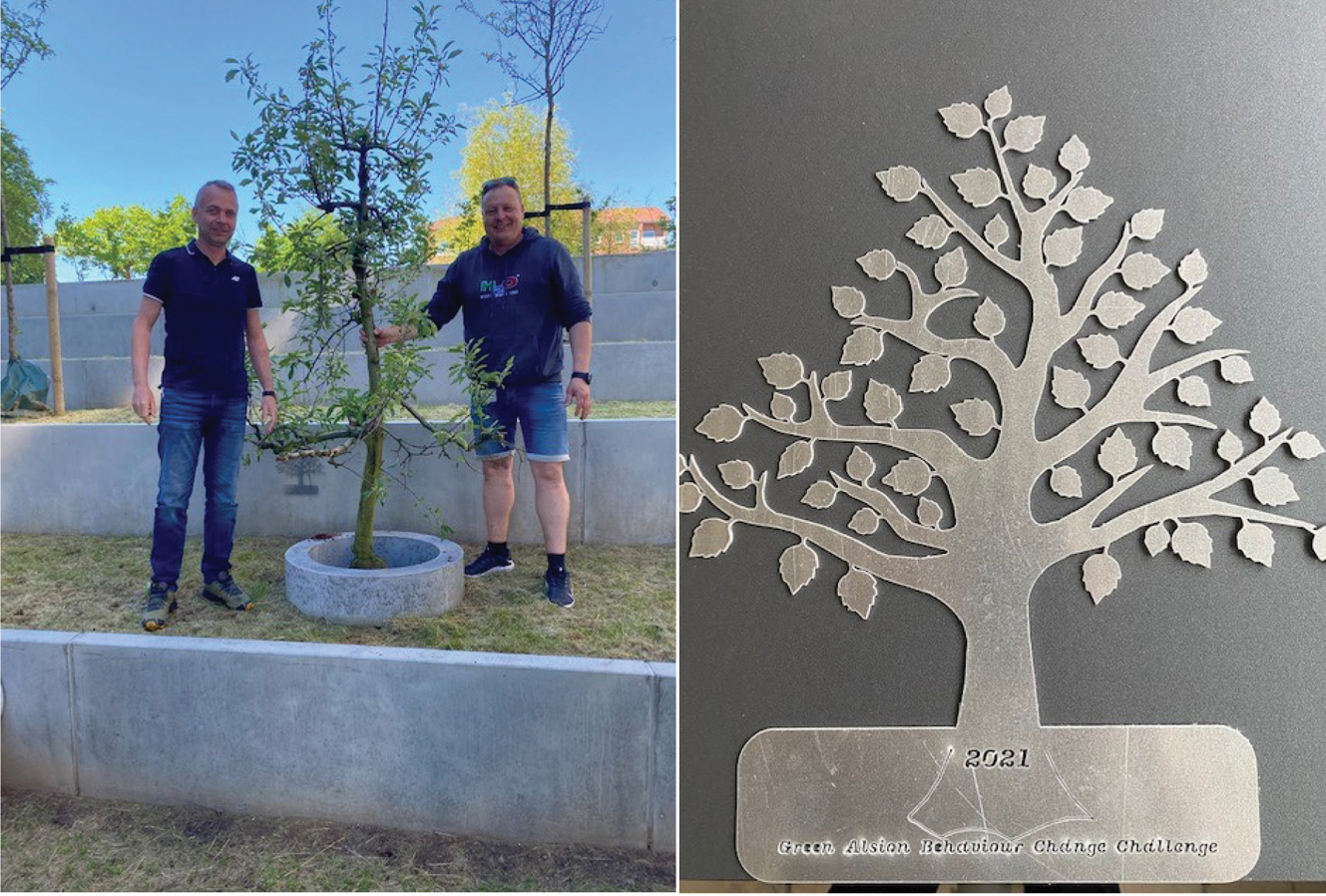Behaviour Change Challenge
The challenge rules
Previous winners
The Behavior Change Challenge is an annual competition for inducing
Behaviour change:
Competing to make the university more sustainable

What is the competition about?
The competition takes place in the framework of the Green Alsion Initiative at the international campus in Sønderborg but addresses all students that have ideas for a more sustainable Alsion.
Where?
The competition takes place in the framework of the Green Alsion Initiative at the international campus in Sønderborg but addresses all students that have ideas for a more sustainable Alsion.
When?
The deadline for the behavior change challenge is July 4th, but in case you need support on your project, please write to Kerstin Fischer (kerstin@sdu.dk) as soon as you have an idea.
The winners will be announced and celebrated during the Climate Conference in September.
What’s at stake?
We planted an apple tree for our Behavior Change Challenge, and the winner's name will be presented next to it for all eternity! You will receive the same metal plate to take home. All participants will receive a certificate of participation..
What do you have to do?
Carry out some kind of behavior design project, in which you demonstrate that your idea has a measurable effect. Describe your project and its outcome in a short paper of up to two pages by July 4th .
Please let us know beforehand that you are planning to submit - this allows us to plan better and you to receive some additional guidance, resources and moral support!
Podcast
You can listen to our podcast on the main ideas of the challenge HERE.
For information, please feel free to contact: Kerstin Fischer
Winners of the Behaviour Change Challenge 2025:

Aleksandra Wytulany, Malgorzata Gulczynska, Katja Marchewka and one other
Art Meets Energy: A Creative Spark at the Climate Neutrality Conference 2025
It began with the question: How do we raise public awareness about organic solar cells?
Four students dared to answer that question—not with data charts or policy briefs, but with paintbrushes, light, and imagination.
At this year’s Climate Neutrality Conference 2025, the spotlight fell on a project that turned heads and opened minds. The winners of the Behaviour Change Challenge—Aleksandra Wytulany, Cecilie Rohde Sloth Møller, Maja Sofie Holst Hansen, and Malgorzata Gulczynska—didn’t just aim to reduce carbon footprints. They aimed to bridge the gap between cutting-edge technology and public awareness, using a medium that speaks to the soul: art.
Their project centred on Organic Solar Cells (OSCs) - a promising, flexible, and aesthetically pleasing renewable energy technology that is still relatively new. To bring OSCs into the public eye, the team launched an art competition, inviting creatives from all walks of life to experiment with OSC kits and transform them into expressive artworks.
The result? A dazzling fusion of science and creativity. The initiative didn’t just raise awareness - it sparked curiosity, conversation, and community engagement.

Two artists stood out among the submissions: Sara Khoshhal Saghalaksari and Benedikte Knorr Jensen, whose winning pieces captured the elegance of OSCs. Their works, now proudly displayed, spark curiosity about these new solar cells
Behind the scenes, the project was guided by the steady hands and sharp minds of Kerstin Fischer and Matouš Jelínek, whose supervision helped shape the challenge into a meaningful and impactful endeavour.
And for those hungry to dive deeper into the story, the team has shared their journey in a podcast episode. 🤓
The Behaviour Change Challenge of 2025 changed perspectives.

Plate at SDU in Sønderborg with all winners of the competition.
Winners of the Behaviour Change Challenge 2024:
The Behavior Change Challenge 2024 winners, Lena C. Eisenacher, Suzanne F. Hün, and Andreas V. Petterson, were honored at the Climate Neutrality Conference at Alsion in September for their work on reducing energy consumption in an optical lab.
Their project focused on developing an interface to prompt lab users to reduce power consumption. The proposed solution is a cutting-edge interface displayed on a strategically positioned tablet next to a machine in the lab. This allows users to monitor the machine's usage and turn it off when not in use. The interface also provides real-time data on power and noise levels, as well as previous power consumption, motivating users to conserve energy.
The potential power savings from this proposal are significant. Estimates suggest that turning off two machines for an hour a day could lead to an annual saving of around 2470 kWh, which is a bit less than the average Danish household's consumption. If applied to 10 other machines in this lab with similar power consumption, the potential savings could be as much as 20000 kWh per year, assuming only one fewer hour of runtime per machine. While the exact savings are uncertain, the potential impact of this solution is substantial.
Winners of the Behaviour Change Challenge 2023:
Congratulations to Alara Tezcan, Vivienne Pirker and Klara Sertl. This year's winners participated in a summer school of SDU here at Alsion: Behavior change for a sustainable future, led by Kerstin Fischer. They performed their winning example within these two weeks.
They addressed how to change people's behavior at Alsion to eat more plant-based food and conducted a field study in our Café Alsion. In arrangement with our kitchen chef, Max Wilhelmsen, they hung up posters to announce the veggie meal of the day, invented some catchy names for the dishes like “Late summer harvest Savoy cabbage with exotic bamboo” and pointed out their nutritional value, and experimented with the placement of the dishes.
With all this in place, they conducted a survey and noted their observations before and after the changes. They also caught the interest of our kitchen staff, which is positive as it will lead to more discussion about eating habits.
Within the short testing period, they saw a significant rise in the consumption of half-vegetarian plates, where half of the items were plant-based and a decrease in non-vegetable plates.
And obviously it was also fun for the three winners as Vivienne Pirker states:”I loved participating and working with my two colleagues!”
Winners of the Behaviour Change Challenge 2022:
Ali Asadi and Beatrice Bernasconi examined whether visualized interventions can persuade people to save electricity. They placed signs in classrooms at the Alsion to encourage students and staff to turn off TVs and video projectors. Data were collected over two weeks before and after placing the interventions. The analysis shows that a significant number of electronic devices were turned off after implementing interventions. Thus, visualized interventions can be an effective way to induce more sustainable behaviour.
The award was presented during the BHJ Award Ceremony at SDU in Sønderborg in November 2022. Listen to our podcast for an interview with Ali and Beatrice here.
Winner of the Behaviour Change Challenge 2021:
Selina Sara Eisenberger investigated the effects of a co-design workshop on behaviour, more specifically, to decrease electricity consumption in a lab. The design workshop was conducted together with the roll-to-roll (R2R) lab at SDU Sønderborg, and the energy consumption was read out manually two weeks before and two weeks after the workshop with the help of a meter installed in the lab to measure and compare the effect. The data collected supports a significant decrease in energy consumption after the co-design workshop. The example demonstrates that pro-environmental behaviour can be induced by engaging users in a co-design.

Thanks to Tony (left), Chres (right), and Knud for their efforts in getting the tree and planting it and for the plate.
We also thank the MCI for the financial support.
